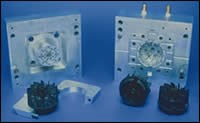Dispelling Myths of Rapid Tooling
Six myths of rapid tooling will be dispelled by examining the truth. This will enable the moldmaking and injection molding industries to better accept and sell the growing trend of aluminum tooling.
Rapid prototyping (RP) and rapid tooling (RT) technologies, processes and developments have changed over the years, but there is one thing that has remained constant: the challenge to get functional prototypes and a method to obtain low-volume production parts fast, without breaking the bank.
The race in rapid tooling to get either functional prototypes or low-volume production parts has created many methods of rapid tooling, which have worked well and not so well. The downside to each of these methods has been the consistency and the lack of broad use from application to application.
Old school rapid tooling was very niche-specific. One method would work well for open and closed molds, while another method was better for running 20,000 parts. Previous methods that were used include Direct Aim tooling, epoxy tooling, SLS Laserform and Keltool. These methods had their strengths, but carried stronger weaknesses—such as poor tolerance, tool life and narrow material selections that you could inject under pressure.
Since people tried to use these niche methods of RT across a broad base of projects and had more failures than successes, people started to label all methods of RT as very limited. Once people were exposed to a less than successful RT project, these labels became gospel.
However, times have changed, and it is time to dispel these rapid tooling myths, which have plagued the RT industry and prevented many people and customers from successfully benefiting from the technology. It is important that people are exposed to the truth about RT. Here are the six main myths of RT that have plagued the industry.
- You cannot make tool modifications in a rapid tool.
- You cannot capture undercuts in a rapid tool.
- You cannot shoot clear parts in a rapid tool.
- You cannot shoot high volumes in a rapid tool.
- You cannot shoot large parts in a rapid tool.
- You cannot shoot most engineering grade materials in a rapid tool.
Before the myths are dispelled, we should first describe what method of rapid tooling we are discussing. This method is using 7075-T6 aluminum rapid tooling that has been milled using high-speed milling (30,000-42,000 rpms). Delivery of these molds varies from vendor, but in general you can get a consistent delivery in two to three weeks.
Six Truths of Rapid Tooling
1. You can make tool modifications in a rapid tool.
Aluminum tools can be welded, inserted and re-machined. In fact, for every 10 molds made, six get modified after the first sampling due to part redesign. This has been a great advantage because now people can spend less time and money making tool modifications on a prototype mold rather than spending even more time and money in changing the production mold.
Changes in molds can vary from changing part features, hole sizes, eliminating sink and even changing gate locations. Most of these changes occur after first parts are shot, assembled and tested. With spec materials fit and function are now easy to test under real elements. If adjustments are required the tool is then modified to meet the new part design.
2. You can capture undercuts in a rapid tool.
Undercuts, side actions or side pulls can all be designed to be captured in aluminum tools. These features can be captured by hand pick-outs and manual slides. By making these pick-outs manual, it keeps cost and delivery to a minimum. This is advantageous to the customer, but not the supplier because it adds complexity to the mold design, the machining and the mold assembly.
The biggest disadvantage to the supplier is that you need to run these molds in a press with a processor at the machine to manually disassemble all the pickouts. If you only run open and close tools, these molds can run unattended. This is the reason many people did not offer making rapid tools with undercuts. With newly developed moldmaking software and a better awareness of cycling at the press, molds are being shot everyday capturing undercuts with hand pickouts and manual slides.
3. You can shoot clear parts in a rapid tool.
Aluminum molds can be polished and/or textured to shoot clear or transparent parts. This is a secondary procedure, the same as you would have in a production mold. The aluminum can be polished up to an A-2 finish. A-3 is more typical and lasts longer in production runs. Depending on the material being run, the A-2 finish might see more wear and dull the finish over time.
Polycarbonates and acrylics are the most commonly run materials to get a clear plastic part. Many materials have been run
with a custom transparent tint from Udel to polycarbonate.
4. You can shoot high volumes in a rapid tool.
High volume is a relative term, so let’s define it as 50,000 parts. Obviously, a lot of projects need runs larger, but 50,000 is quite a contrast compared to the 500 quantities that were rumored off rapid tooling. These volumes are limited to material and part design, but many molds have shot abrasive materials with multiple pickouts in the tens of thousands.
Again, processing at the press and having the need for speed, but not the greed for speed are the important variables in running larger runs. If you are trying to match production mold cycle times with aluminum, you will eventually run into issues. If you use common sense and finesse, you will capture benefits of higher volumes from your aluminum tool.
5. You can shoot large parts in a rapid tool.
Again, this is a relative term. Large parts for a medical company may not be considered large for an automotive company. The point in this myth being dispelled is that aluminum tools are not limited to a six-inch cube.
On average, many parts do fit into this frame. There are still many parts that exceed the 18" x10" x6" envelope that are being made in an aluminum rapid tool. This is a very common practice that allows for great price reductions and helps in reducing leadtimes.
6. You can shoot most engineering grade materials in a rapid tool.
Using aluminum tools allows you to sample the same materials as you would in a production mold. Glass-filled Nylon, Ultem, Peek and PVC have all been run in aluminum tools. These molds can be cooled or heated to meet the processing requirements. The day of only shooting ABS or Santoprene is over. Filled materials, exotic materials and waxes are all being sampled in aluminum tools everyday to get functional prototypes or low-volume production parts.
These are the six main myths that have held aluminum tooling back from helping to jumpstart projects into a smoother transition in production. Other myths that should not be ignored are the ability to also do insert molding, over molding and making family tools. Also, tolerance in a rapid tool does compare to a production tool. This has been proven time and time again from first runs to final runs.
In conclusion, many projects have been brought to production with questions unanswered, over budget and with forecasts and timelines being missed that could have all been prevented by using rapid tooling. The next time you have a need for 50 to 50,000 parts from a spec material, do not let the myths of rapid tooling lead you astray.
Related Content
2024 Moldmaking Insights: A Year in Review Part 1
A look back at the top moldmaking trends of 2024, as revealed through MMT's analytics. This review highlights the most popular technical articles, case studies, tips and best practices that captured the industry's attention over the past year.
Read MoreIn "Hybrid" FIM Process, 3D Printing Complements Injection Molding
Alpine Advanced Materials used a desktop 3D printer and the freeform injection molding process to reduce prototype tooling production time and cost for its customers.
Read MoreThe Connector Conundrum: 3D Printed Mold Tooling’s Role in Innovation
ReelView Fishing faced an electronics obstacle in the development of its new technology for underwater video. Additive manufacturing for moldmaking enabled the speed necessary to iterate to a solution.
Read More3D Printing Speeds Prototyping and Shifts Talent to Production Tooling
A digital approach to prototyping using 3D-printed tooling accelerates product development and frees up mold builders for production tooling work.
Read MoreRead Next
Time and Money Saved with RP/RT Strategy
Using a variety of rapid prototyping and rapid tooling techniques, 3M was able to bring a new product to market faster and less expensively.
Read MoreOvercoming Pain Points in Moldmaking with AI
Shops that embrace AI as a tool, not a threat, can enhance efficiency, preserve expertise, and attract tech-savvy talent.
Read MoreHow to Use Strategic Planning Tools, Data to Manage the Human Side of Business
Q&A with Marion Wells, MMT EAB member and founder of Human Asset Management.
Read More
























